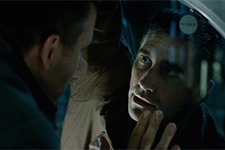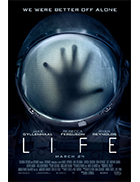Life (2017)
|  Throughout the history of science fiction movies, starting with Georges Méliès’s A Trip to the Moon (1902), there have generally been two varieties of storylines involving humankind coming into contact with aliens. The first is optimistic, in which humanity somehow benefits or learns from their contact with what inevitably turns out to be a higher, more evolved life form. We can see this in Robert Wise’s The Day the Earth Stood Still (1951), whose basic premise of peaceful aliens warning us about our inevitable self-destruction was borrowed by James Cameron in The Abyss (1989). We see it abstractly in Stanley Kubrick’s 2001: A Space Odyssey (1968), in which humanity evolves as a result of alien encounter, and obliquely in Steven Spielberg’s Close Encounters of the Third Kind (1977), which celebrates the ability of human and aliens to communicate. And then there’s the pessimistic variety, in which the aliens want to do little more than destroy us. There were innumerable such films during the Cold War, ranging from an alien rampaging through an Arctic research facility in Christian Nyby and Howard Hawks’s The Thing From Another World (1951), which John Carpenter remade in grisly-gonzo fashion in 1982, to the title-explaining Earth vs. the Flying Saucers (1956) and War of the Worlds (1953), invasion nightmares that Roland Emmerich and Dean Devlin reimagined with colossal digital effects in Independence Day (1996). Despite its seemingly optimistic title, Life falls squarely in the latter category, as it tells the story of a group of scientists on the international space station orbiting Earth battling what begins as a single-celled organism brought back in a soil sample from Mars. As one character puts it, “Life requires destruction,” which pretty much sums up the film’s ethos. Life is, at its core, survival, and survival often requires the destruction (and consumption) of others, which is clearly how this particular alien feels, if it feels anything at all. Explained as a being whose every cell is simultaneously a muscle cell and a nerve cell, it is a horrifically simple creature that grows at an astronomical rate, progressing from a single cell under a microscope, to a tiny glob of spindly tendrils, to an increasingly large, semi-translucent blob that looks like a kind of octopus that “swims” through zero gravity with frightening speed. We can find the basic model for Life in Ridley Scott’s Alien (1979), which in turn owes more than a small debt to The Thing From Another World. All three films are essentially horrorshows that take advantage of the human characters’ entrapment within a limited space with an unknown creature picking them off one by one. Director Daniel Espinosa (Safe House) is particularly effective in making use of the severely limited confines of the space station to heighten the tension in Life. This is not the giant spacecraft of Alien, with wide corridors, high ceilings, and enormous storage rooms that resemble a Gothic dungeon, but rather a realistically portrayal of current space technology, in which the entire station is constructed of modules that have been fit together over time. There is barely enough room to move about, and because all actions are conducted in zero gravity, up is down and down is up. Once the alien lifeform gets loose from the confines of the research lab, it could literally be anywhere. This puts the station’s human residents at a severe disadvantage, especially once they realize that the creature can survive for lengthy periods of time in the otherwise lethal vacuum of space. Screenwriters Rhett Reese and Paul Wernick (who previously collaborated on the much funnier genre fare Zombieland and Deadpool) follow the Alien template in establishing the human characters on largely equal ground so that it is difficult to know who will die first and who, if any, will survive. The presence of several above-the-marquee movie stars, including Jake Gyllenhaal as a sullen, misanthropic doctor and Ryan Reynolds as a (surprise!) sarcastic engineer, offer some suggestions as to who might make it, but don’t be too sure. The characters remain fairly flat, if only because not much time is spent developing them. The film’s opening scene, which is an impressive long take that snakes in and around the station while everyone scrambles to intercept the satellite returning from Mars with the soil samples, is an aesthetic tour de force that throws us immediately into the action with little set-up. We meet all the characters, which also include a pilot (Hiroyuki Sanada) and the head researcher (Ariyon Bakare), but they are interesting only in terms of the roles they play on the station and eventually in either fighting the alien creature or succumbing to it. At its heart, Life is a goosey B-movie with A-list stars, cinematography (courtesy of two-time Oscar nominee Seamus McGarvey), and digital effects. Its lack of ambition isn’t really a detriment, as it goes about its work with admirable efficiency and effectiveness. It reminded me more than anything of the various low-budget Alien knock-offs that poured into theaters in the early 1980s, many of which were produced by Roger Corman and all of which spun similar yarns but with largely unknown actors, more nudity, and much poorer effects. These included B.D. Clark’s Galaxy of Terror (1981), which managed to combine the horrors of Alien with the Freudian notion of projected fears taking on their own physical existence from Forbidden Planet (1956), and Allan Holzman’s Forbidden World (aka Mutant) (1982), with its gooey human-alien genetic experiment gone bad. Like those films, Life is happy to indulge in the basic thrills inherent in its storyline without much recourse to grand themes or noble ambitions. Its simplicity and directness are its true virtues, although points must also be awarded to its willingness to follow through with an awful inevitability, delivering the kind of gut-punch final image that makes horror truly horrific. Copyright © 2017 James Kendrick Thoughts? E-mail James Kendrick All images copyright © Sony Pictures |
Overall Rating: 

 (3)
(3)


